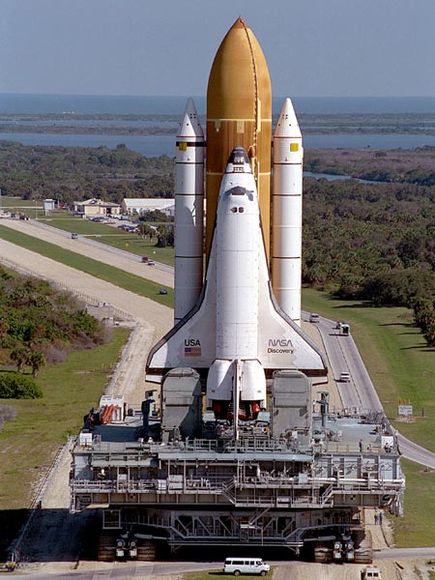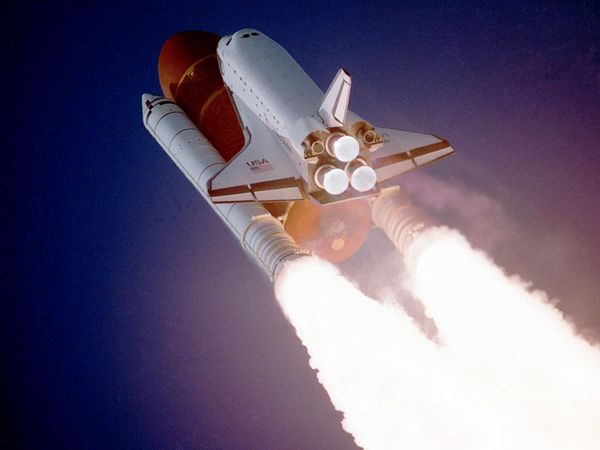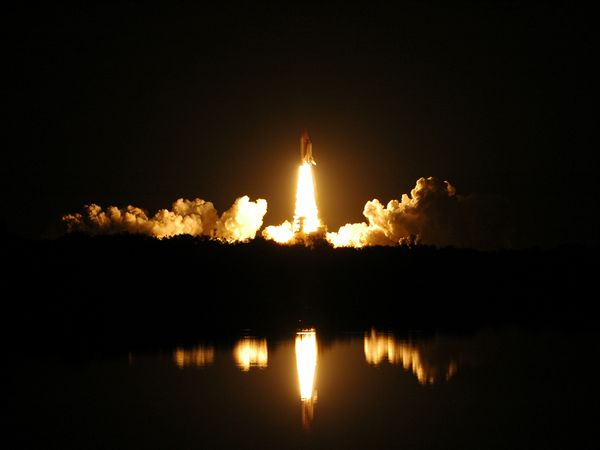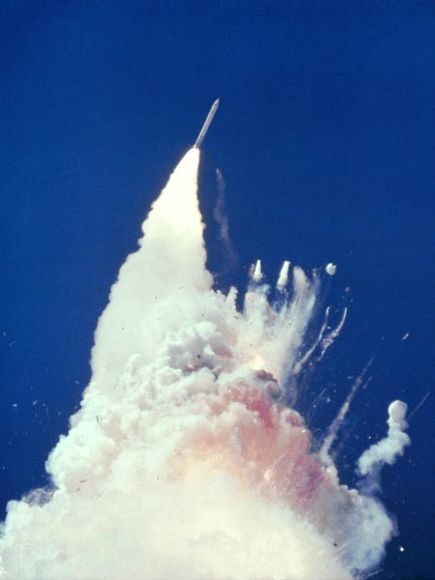The Space Shuttle Program was a manned launch vehicle program operated by the US government through NASA. Officially, the program was known as the Space Transportation System (STS). Beginning in 1981, the program operated for 30 years until its retirement in 2011.
In this article, we explore everything about the space shuttles including their design, missions, accomplishments and disasters. We will also explore where the shuttles are today. 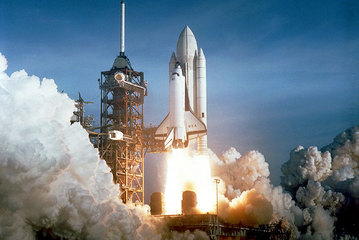
The Launch of the First Shuttle Flight STS-1 Image Source: Space.com
The Space Shuttles Were the First Reusable Spacecrafts
Before this program, spacecrafts were designed to perform single missions. The space shuttles were designed with reusable components. Each space shuttle was capable of performing 100 launches in its 10 years of operational life. This reduced the cost of space exploration significantly.
The Space Shuttle Had a Sophisticated Design with Three Major Components
The space shuttle was the most complex and sophisticated vehicle ever build. Maxime Faget, the same person responsible for the design of the Mercury, Gemini and Apollo spacecrafts, was in charge of the design of the space shuttles. Each shuttle had a propulsion system, an external fuel tank (ET) and an orbiter space plane.
Propulsion System
The shuttles had two solid rocket boosters that provided the thrust required to lift the space shuttle off the launch pad while supporting the weight of the orbiter and fuel tank.
After their use, the rocket boosters parachuted to a splashdown in the ocean where they were recovered and refurbished for use on another flight.
Each shuttle had three large engines that took over from the boosters after the first two minutes of the launch until the shuttle reached orbit. These were the first reusable rocket engines ever developed and could operate for 55 flights.
Once the shuttle entered orbit, two orbital maneuvering system (OMS) engines located on both sides of the aft fuselage became the source of thrust for major orbital changes.
Once in flight, the reaction control system composed of 44 small rocket engines took over. These were located on the nose and both side of the tail to enable the exacting maneuvers required while in orbit.
The External Fuel Tank
The external fuel tank was the largest component of the space shuttle. It contained the fuel consumed by the engines during the launch. It also served as the backbone to the launch vehicle being the attachment point for the boosters and orbiter.
The external tank was the only component of the shuttle that was not reused. After it did its work, it was jettisoned from the orbiter and disintegrated in the upper atmosphere with pieces falling into remote parts of the ocean.
The Orbiter Space Plane
The orbiter was like the brain and heart of the space shuttle system. It carried the astronauts and the payload. It was as large as a tour bus. It had to have a 1000-mile cross-range recovery range and the orbiter had large wings to achieve this requirement. The orbiter space plane was recovered after a mission and refurbished for use on another mission.
One unique design aspect of the shuttle was that it had a large cargo bay with doors that opened along the length of its top. This design gave it the capability to transport large satellites to space as well as retrieve and return large payloads back to Earth.
There Were Three Successful Operational Orbiters and One Experimental Orbiter Missions
Enterprise
Enterprise was an experimental orbiter whose purpose was to conduct approach and landing tests. It was the first launch in the program but it did not fly into orbit because it did not have a heat shield or engines.
Its original name was Constitution but it was renamed after Captain Kirk’s starship in the Star Trek movie due to popular demand.
Discovery
Discovery was the third shuttle to fly in space. It flew on its first mission in 1984 and became the most traveled space shuttle after completing 39 missions.
One of its accomplishments is launching the Hubble Space Telescope into space. It also played a major role in building the International Space Station.
Space Shuttle Discovery Image Source: NASA
Atlantis
Atlantis was the last space shuttle to fly in space before the program was retired in 2011. It completed 33 missions making trips to space stations, launching several spacecrafts in orbit and servicing the Hubble Space Telescope. It also carried out secret military missions.
Space Shuttle Atlantis Image Source
Endeavour
Endeavour was the youngest space shuttle in the program. It was named after the ship James Cook used on his journey to study the transit of Venus.
Endeavour made 25 space flights including visits to the International Space Station and Russian orbiting laboratory, Mir.
Endeavor Shuttle Launch Image Source: National Geographic
Space Shuttle Missions Launching of the Space Shuttles
The space shuttles launched vertically just like conventional rockets. The Kennedy Space Center (KSC) in Cape Canaveral, Florida was the space shuttle launch facility. The mission control center was at the Johnson Space Center in Houston, Texas.
Launches were done after checking the weather and confirming that there was no possibility of lightning. A typical mission lasted 7-8 days but could take up to 14 days if the mission objectives required more time.
The Space Shuttle Crew
The space shuttle crew was composed of a minimum of two people and up to seven people who carried out different responsibilities to ensure the success of each mission.
The commander was the leader of the crew and he was assisted by the pilot. These two were responsible for flying the shuttle and were always professional astronauts and pilots with extensive experience with space systems and operations training.
A mission specialist served as the lead astronaut. He ensured that the mission objectives were achieved.
The rest of the crew was composed of payload specialists and mission experts. These were usually astronauts from different countries participating in a particular mission.
Reentry and Landing of the Space Shuttles
After completing a mission in space, the shuttle fired the maneuvering system engines to slow down, move out of orbit and re-enter the Earth’s atmosphere.
This was followed by a series of maneuvers that transformed the shuttle from a spacecraft to an aircraft. The shuttle would land like an aircraft horizontally on a conventional airport runway. The landing sites were usually the Kennedy Space Center or the Edwards Air Force Base.
The re-entry and landing was mainly computer controlled. Only the lowering of the landing gear and deploying of the air data probes was accomplished manually. Manual reentry was reserved for emergencies.
The approach and landing was usually controlled by hand even though autopilot operation was possible.
Space Shuttle Landing Image Credit: NASA
Accomplishments of the Space Shuttle Program
The space shuttle was the only winged manned spacecraft to have achieved orbit in space and land on Earth. It was also the only reusable space vehicle to have ever made multiple flights into orbit.
The shuttles were used during orbital space missions. They made plenty of successful missions enabling significant accomplishments in scientific research.
The space shuttles carried human beings on space missions, delivered payloads including satellites and space station parts into orbit, recovered and serviced satellites in space, carried out scientific research, performed military missions and went on interplanetary missions.
One of the biggest accomplishments was the completion of the International Space Station where the space shuttles were an important means of transport for both the crew and cargo.
The shuttles also delivered scientific experiments into space. A good example is the Spacelab, which was composed of science, physics and other experiments arranged in a modular manner in the shuttle’s cargo bay.
The Space Shuttle Disasters
The space shuttle program had its share of lows. Out of the five operational orbiters developed in the program, two of them were destroyed in tragic accidents.
Challenger Disaster
On January 28, 1986, the space shuttle Challenger exploded less than two minutes after launch with millions of people watching on TV killing the seven crew members instantly. STS-51-L was the ill-fated mission.
Investigations revealed that the explosion was caused by a gas leak after a seal on the right solid rocket booster failed.
After this accident, the shuttles were grounded for three years, as scientists sought ways to improve safety of the shuttles.
Space Shuttle Challenger Disaster Image Source: NASA
Columbia Disaster
On February 1 2003, space shuttle Columbia exploded during reentry killing the seven crew members instantly.
This disaster occurred just about 16 minutes to the shuttle’s expected landing after carrying out mission STS-107. The orbiter broke off over Texas and then exploded when a piece of insulated foam separated from the external tank and hit the orbiter’s left wing.
After this accident, the remaining Shuttles were kept away from the launch pad for a long time before resuming their normal routines. This time allowed for mourning, investigation and gave scientists an opportunity to focus on improving the design of the shuttles to improve safety.
Debris Disintegration Just Before The Explosion Image Source
The Space Shuttle Program Retirement
The original project timeline for the space shuttle program was 15 years. However, several extensions saw it lasting 30 years and carrying out 135 missions.
The last space shuttle mission, STS-135, ended on July 21, 2011 when the Atlantis landed safely on Earth. The program was retired in August 2011.
The Space Shuttles Are Now On Public Display
The space shuttles are now on public display in various museums in the US and open for viewing by the public. Enterprise is in the Intrepid Sea, Air & Space Museum in New York, Discovery is at the National Air and Space Museum, Atlantis is displayed in the Kennedy Space Center Visitor Complex of NASA, and Endeavour is at the California Science Center in Los Angeles.

